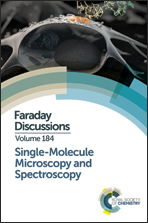Enhanced Raman scattering from aromatic dithiols electrosprayed into plasmonic nanojunctions
Abstract
We describe surface enhanced Raman spectroscopy (SERS) experiments in which molecular coverage is systematically varied from 3.8 × 105 to 3.8 × 102 to 0.38 molecules per μm2 using electrospray deposition of ethanolic 4,4′-dimercaptostilbene (DMS) solutions. The plasmonic SERS substrate used herein consists of a well-characterized 2-dimensional (2D) array of silver nanospheres (see El-Khoury et al., J. Chem. Phys., 2014, 141, 214308), previously shown to feature uniform topography and plasmonic response, as well as intense SERS activity. When compared to their ensemble averaged analogues, the spatially and temporally averaged spectra of a single molecule exhibit several unique features including: (i) distinct relative intensities of the observable Raman-active vibrational states, (ii) more pronounced SERS backgrounds, and (iii) broader Raman lines indicative of faster vibrational dephasing. The first observation may be understood on the basis of an intuitive physical picture in which the removal of averaging over multiple molecules exposes the tensorial nature of Raman scattering. When an oriented single molecule gives rise to the recorded SERS spectra, the relative orientation of the molecule with respect to vector components of the local electric field determines the relative intensities of the observable vibrational states. Using a single molecule SERS framework, described herein, we derive a unique molecular orientation in which a single DMS molecule is isolated at a nanojunction formed between two silver nanospheres in the 2D array. The DMS molecule is found lying nearly flat with respect to the metal. The derived orientation of a single molecule at a plasmonic nanojunction is consistent with observations (ii) and (iii). In particular, a careful inspection of the temporal spectral variations along the recorded single molecule SERS time sequences reveals that the time-averaged SERS backgrounds arise from individual molecular events, marked by broadened SERS signatures. We assign the broadened spectra along the SERS time sequence – which sum up to a SERS background in the averaged spectra – to instances in which the π-framework of the DMS molecule is parallel to the metal at a classical plasmonic nanojunction. This also accounts for Raman line broadening as a result of fast vibrational dephasing, and driven by molecular reorientation at a plasmonic nanojunction. Furthermore, we report on the molecular orientation dependence of single molecule SERS enhancement factors. We find that in the case of a single DMS molecule isolated at a plasmonic nanojunction, molecular orientation may affect the derived single molecule SERS enhancement factor by up to 5 orders of magnitude. Taking both chemical effects as well as molecular orientation into account, we were able to estimate a single molecule enhancement factor of ∼1010 in our measurements.
- This article is part of the themed collection: Single-Molecule Microscopy and Spectroscopy

 Please wait while we load your content...
Please wait while we load your content...